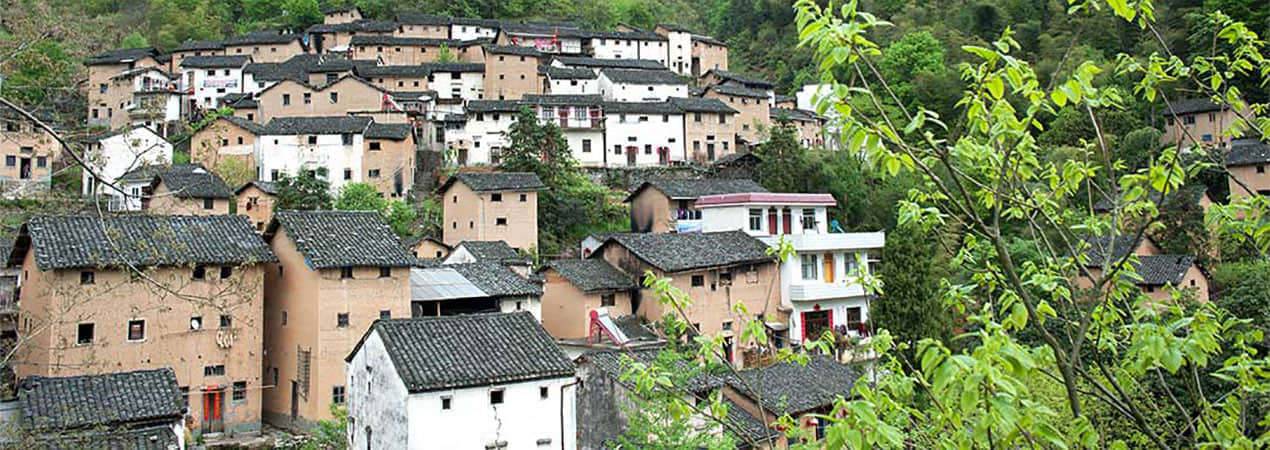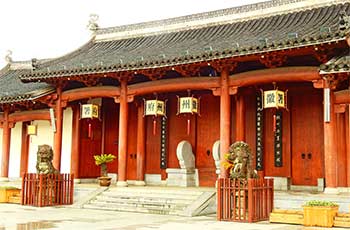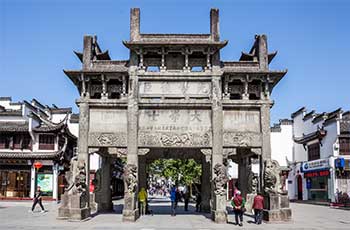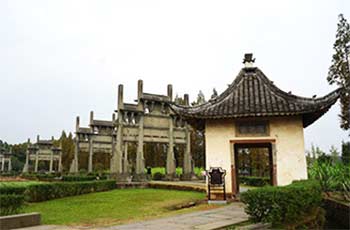Shexian County

Shexian County is located at the southernmost end of Anhui Province. In ancient times, it was Huizhou’s provincial capital and its political, economic and cultural center. With the blend of beautiful natural landscape and ancient buildings, it is like a gallery of rivers and mountains as well as a museum of classic architectural art. From ancient to modern times, the Huizhou people have always resided in the white-washed and dark-tiled houses with bluestone-paved ground. You may sense the historical rise and decline when strolling around.
- Chinese Name: 歙县 Shè Xiàn
- Building time: Qin Dynasty (221-207 BC)
- Duration: 3 hours
- Entrance fee: RMB 100 per adult (including Hui Park, Huizhou Government Office, Xuguo Stone Archway, Doushan Street, Xin’an Stele Park, Building, Taoxingzhi Memorial Hall, Yuliang Town)
- Opening hours: The Ancient City is open full day and the small scenic spots inside are open from 8 am to 5 pm.
- Address: At the center of the county (close to Xin’an Road)
- Best time to visit: All year round
- Bus lines: Take bus from Shexian County Bus station to the ancient city, which costs RMB 7; or take bus No.3 or 4 at Shexian County and then get there on foot.
Highlights at Ancient City of Shexian County:
Doushan Street
This street is a cultural scenic spot integrating folk residences, streets, carvings, wells and archways of ancient times. The narrow bluestone-paved roads are long and extensive. Doushan Street offers a typical Hui-style Wang’s residence, Officer Yang’s Mansion, Xu’s ancient private school, Merchant Pan’s residential compound, and a rare wooden shield archway —“Ye’s chastity archway”, and more.
 Hui Park
Hui Park
Hui Park:
Known as “the Grand View Garden of Huizhou Culture”, Hui Park is an archaic tourist city rebuilt from the original Huizhou government office in the center of Shexian County. It was opened on November 16, 2000, reflecting Huizhou’s landscape in the Ming and Qing Dynasties. With imposing momentum and elegant charm, the archaic garden has orderly buildings and exquisite carvings, inheriting the spirit of Huizhou culture as well as representing the essences of new Hui-style buildings and carving. Hui Park reflects the highest level of “3 top ancient Huizhou buildings”— archways,ancestral halls and folk residences, and collects the essences of “3 featured Huizhou carving”— brick carving,wood carving and stone carving.
Xuguo Stone Archway:
 Xuguo Stone Archway
Xuguo Stone Archway
The archway was built in October of the 12th year of the Wanli ruling period in the Ming Dynasty (1584) with a history of over 400 years. It is a type of building with wooden structure, decorated with delicate carvings, including a colored phoenix, flying dragons, and other particular fowls and beasts. There are 12 stone lions leaning on the pillars and lying on the stone bases, presenting a vivid picture. Inscriptions have been carved on all sides of the stone archway. Xuguo Stone Archway is the most outstanding one among all the stone archways in Huizhou, comprehensively demonstrating the highest level of the building techniques of stone archways. Its structure of 4 towering pillars and 3 floors has enjoyed a great reputation for hundreds of years during the Ming and Qing Dynasty and it occupies a prominent and unique position in the Chinese history of stone archways.
Taibai Building
With mountains as a backdrop, Taibai Building is located beside the Lianjiang River to the west of Shexian County, at the west end of Taiping Bridge, and close to the Xin’an Stele Park. According to legend, it was a liquor store. In the Tang Dynasty, the Fairy Poet Li Bai once came to visit the hermit Xu Xuanping but failed,and then drank liquor here. In memory of Li Bai, the store was renamed “Taibai Building”. The Building was built in the turn of the Tang and Sui Dynasty. And the existing houses were rebuilt in the Ming and Qing Dynasty. Taibai Building is a two-storied construction with two entrances, covering an area of over 200 m2. The front plane is in the shape of “凸” with the middle part protruding and the two flanks retracted. The building has a relatively low ridge and horse-shaped walls at two ends. It also has a steep roof and double eaves with raised edges. Under the eave hangs a horizontal board inscribed with three Chinese characters—“Tai Bai Lou”. Downstairs is a three-door entrance on the front. The ancient road along the river runs through the door on the left to that on the right. Several steles, which record the rebuilding of Taibai Building through the dynasties, are embedded into the interior wall.
 Xin'an Stele Park
Xin'an Stele Park
Xin’an Stele Park
The park is a typical Hui-style private garden building located at the foot of Piyun Peak to the west of the ancient city. Backed by mountains, it was built according to the surrounding terrain with various flower walls, ornamental perforated windows and portals connecting with each other. The zigzag stele corridor extends over 200 meters. Inside the park are pavilions, ponds, fake mountains, stalagmites, little bridges, flowing waters, flowers and plants, all with a unique style and charm. Over 200 well-preserved steles of famous calligraphers of the Song, Yuan, Ming and Qing Dynasties are displayed in the stele park, which is indeed a rare sight.
Drop us a line and we'll connect you with the top China expert in no time!